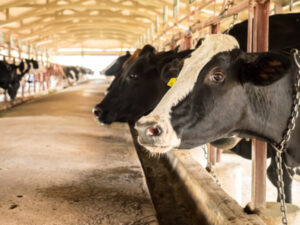Scientists: Hospitals Can Do Something About Antibiotic Resistance

Rather than sitting back and waiting for regulators and lawmakers to fix the problem of antibiotic resistance exacerbated by the prevalent use of antibiotics in livestock, scientists at the University of California San Francisco have called on hospitals to change the food they serve to reduce exposure to patients and other hospital workers and visitors.
In light of recent research that says up to 50 percent of bacteria that cause infections after surgery are resistant to antibiotics in the U.S., hospitals may be the perfect venue for taking such a stand.
In commentary published in the American Journal of Public Health, UCSF scientists pointed to the UCSF Medical Center, which has spent the last two years phasing out meat from animals treated with antibiotics for nontherapeutic purposes. Now, a third of meat served to patients and in hospital cafeterias was purchased from sources that don’t use antibiotics to promote animal growth.
The scientists argue that health professionals should play a role in curbing antibiotic use in agriculture like they did in highlighting the danger of smoking.
While overuse in livestock isn’t our only problem (use among humans is really high, too), it threatens human health, UCSF scientists wrote. The recent research, published last month in The Lancet, found that antibiotic resistance could jeopardize patients undergoing routine surgery.
“Antibiotics are now more and more recognized as a precious resource that needs to be managed sustainably,” Dr. Thomas B. Newman, a professor of epidemiology and biostatistics and pediatrics at UCSF, and an author of the commentary, said in a UCSF news release.
People can come into contact with antibiotic resistant bacteria by eating undercooked meat or touching surfaces where raw meat was prepared.
UCSF is even ahead of its own state. California legislators just passed a law – the first in the country – that limits the use of human antibiotics in livestock. The law will take effect in 2018. The state law cuts out the use of antibiotics to treat diseases attributed to poor hygiene and overcrowding, which is a step further than a Federal Drug Administration guidance that only addresses the growth-promotion aspect of antibiotic use in animals.
Gail Hansen, a public health veterinarian who used to work with Pew Charitable Trusts’ Antibiotic Resistance Program, said expanding the FDA guidance is next on the public policy list. As a veterinarian, she thinks the availability of antibiotics promotes animal welfare but it doesn’t excuse bad practices, like poor husbandry and hygiene.
“There are ways to prevent disease that don’t include antibiotics. That’s why you clean things in hospitals,” she said in an interview. “A lot of prevention things … can be done before you go to antibiotics.”
But before revisiting its guidance, the FDA needs funding to implement the controls it has already proposed. Then it needs more data to understand how much cutting antibiotic use for growth promotion impacts the overall prevalence of use in livestock.
Advocates say the majority of medically important antibiotics are actually used on cows, pigs, chickens, and other animals raised for food. But no one knows how those antibiotics are specifically used or which animals are treated most, Hansen said.
Where regulators and legislators have to wait years for new rules to take effect, consumer groups, like hospitals, can act more quickly. UCSF scientists note the cost for antibiotic-free meat is higher but by spending more money now, hospitals can build demand for better practices. And as economics dictates, higher demand will increase supply which will drive down prices.
“The marketplace is way ahead of regulation and legislation,” Hansen said.
But market movement doesn’t mean regulation and policies aren’t important, Hansen went on to say. When the U.S. Department of Agriculture puts a rule on the books, they’re subjected to oversight by Congress – an option consumers don’t have if they’re relying on industry to hold itself accountable.
So California’s new law shows promise, she said. The state often leads the way in agricultural policy changes.
“It may show other parts of the country … yes it can be done,” Hansen said. “Farmers and ranchers aren’t all going to go out of business in California.”
Related on Organic Authority
Antibiotic Resistance Now Kills More People Than AIDS
Antibiotic-Resistance Bacteria Found in Nearly 50 Percent of Factory Farm Workers
5 Home Remedies to Fight Bacteria Naturally
Cow photo via Shutterstock

